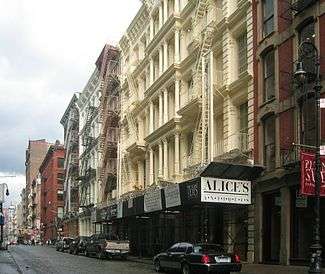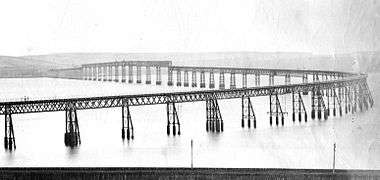Cast-iron architecture


Cast-iron architecture is a form of architecture developed through the use of cast iron. It was a prominent style in the Industrial Revolution era when cast iron became relatively cheap and modern steel had not yet been developed.
Structural use
Cast iron is not a good structural material for handling tension or bending moments because of its brittleness and relatively low tensile strength compared to steel and wrought iron. In a few instances bridges and buildings built with cast iron failed. Cast iron has good compressive strength and was successfully used for certain structural components in well designed old bridges and buildings. Puddled wrought iron, which was introduced after The Iron Bridge was constructed, was a much better structural material. Puddled iron became widely available after 1800 and eventually became the preferred material for bridges, rails, ships and buildings until new steel making processes were developed in the late 19th century.[1][2]
Cast iron has been used for centuries and was used in architecture in the pre-modern period;[3] for instance, the 13th century Indian "Konark Sun Temple" used iron beams.
It was in 18th-century Britain that new production methods first allowed cast iron to be produced cheaply enough and in large enough quantities to regularly be used in large building projects. New production methods included using steam engine powered blast air, which allowed higher blast furnace temperatures, which in turn allowed the use of more limestone to be added with the iron ore charge. The higher furnace temperatures made the slag produced with the additional lime to flow more freely. The calcium and magnesium in the lime helped tie up sulfur, which allowed the use of coke for fuel. The higher furnace temperatures also increased the furnace capacity.[4]
One of the first important projects was The Iron Bridge in Shropshire, a precedent-setting structure made almost entirely of cast iron. However, it was grossly over-designed, and the makers (principally Abraham Darby) suffered financially as a result. The quality of the iron used in the bridge is not high, and nearly 80 brittle cracks are visible in the present structure. Later designers and engineers, such as Thomas Telford, improved both the design and quality of the material in bridges (for example, at Buildwas upstream of Coalbrookdale) and aqueducts (such as the world-famous Pontcysyllte Aqueduct in North Wales).
Architectural use
Cast iron was first used in pagoda construction in Tang Dynasty China.[3] Texts written in the 9th century by the Japanese Buddhist monk Ennin describe in detail the cast-iron pagodas and statues widespread in China at the time. Persecution of Buddhism in China led to the destruction of many of these structures.[3] Ditherington Flax Mill, built in 1796, is considered the first iron-framed building in the world.[5]

The Commissioner's House of the Royal Naval Dockyard, Bermuda designed by Edward Holl and built in the 1820s is considered to be the first residence that used cast iron in its structural framework.[6][7] In the 1850s the cheapness and availability of cast iron led James Bogardus of New York City to advocate and design buildings using cast-iron components. Cast iron could be cast into a wide array of shapes and designs, allowing elaborate facades that were far cheaper than traditional stone-carved ones. These facades could also be painted a wide array of colours. Many of these buildings had elaborate neo-classical or Romanesque designs. Mostly used on commercial and industrial buildings, there are many surviving examples, especially in the SoHo and Tribeca areas of New York and the western downtown area of Louisville, Kentucky. One of the most intact ensembles in the American West can be seen in the Skidmore/Old Town Historic District, a National Historic Landmark in Portland, Oregon. In Europe the best-preserved examples of Victorian cast-iron warehouses can be viewed in Glasgow, Scotland, a city which experienced an enormous expansion in the late 19th century. Another Victorian-era cast-iron structure is the Covered Market in Valletta, Malta, which was built between 1859 and 1861.[8]
In the old cities of the southern United States, the use of cast iron in architecture was pervasive in the late 1800s. New Orleans and Richmond have particularly concentrated and well-preserved examples of cast iron, often in the form of elaborate porches. In New Orleans' French Quarter multi story iron porches cantilever off of masonry walls where as Richmond porches in neighborhoods such as Church Hill and Jackson Ward are more often single-story structures resting on brick piers. Numerous foundries in both cities produced unique ornamental and structural designs in iron.
Cast-iron columns had the advantage of being slender, compared with masonry columns capable of supporting similar weight. That saved space in factories and other kinds of buildings, and enabled architects of theaters, churches and synagogues to improve sight lines when supporting balconies.
Cast iron also became the standard support structure in the construction of greenhouses, and this type of design led to the monumental Crystal Palace built in London in 1851. Designed by Joseph Paxton, the glass-and-cast-iron structure was much imitated around the world.
In the late 19th century modern steel was developed, and it proved far more suitable than cast iron for structural and support purposes. The fashion for cast-iron facades also faded in this era. Many of the innovations of the cast-iron period were carried over to the new steel-frame buildings, and were essential to the development of the modern skyscraper.
Catastrophic failures

Cast iron has some architectural advantages, and some weaknesses. It is strong in compression, but weak in tension and bending. Its strength and stiffness deteriorate when subjected to high heat, such as in a fire. In the early era of the industrial revolution cast iron was often used in factory construction, in part owing to the misconception that such structures would be fireproof. William Strutt pioneered this innovation, building a number of industrial buildings using cast-iron supports. Cast iron was strong enough to support the heavy machinery but was vulnerable to the frequent fires that would occur in such factories. There were also numerous building collapses caused by fracture of brittle cast-iron beams. These often occurred when the bottom side of the beam was in tension, often from defects such as blow holes within the beams. Such internal defects were common in large beams.
Cast iron was also used widely in bridge construction for the new railway system, sometimes with horrific results, especially when cast-iron girders were used instead of arches. The first use was at the Water Street terminus of the Liverpool and Manchester Railway in 1830 to a design by William Fairbairn, a successful design which was demolished about 1900 owing to the widespread concern about cast iron under bridges on the rail network in Britain. Robert Stephenson built a longer bridge over the river Dee, mistakenly adding wrought iron trusses to strengthen the structure. This led to the Dee bridge disaster of 1847, which killed five when the bridge collapsed.
Following the disaster such trussed bridges were demolished and cast iron was replaced with wrought iron composite beams formed by riveting sheets together, and then steel rolled beams when steel became available in the late 1860s and 1870s. Cast iron continued to be used in railway under bridges, and there were a number of serious failures involving loss of life. The most serious accident occurred in 1879 with the Tay Bridge disaster when the centre part of the bridge collapsed in a storm as an express train was passing over. The whole train was lost with more than 75 passengers and crew. The weakest parts of the bridge were cast-iron lugs holding tie bars in place, and cast iron in new bridges was effectively abandoned after the disaster. Most small cast-iron beam structures were demolished and replaced after the Norwood Junction rail accident of 1891.
References
Notes
- ↑ Landes, David. S. (1969). The Unbound Prometheus: Technological Change and Industrial Development in Western Europe from 1750 to the Present. Cambridge, New York: Press Syndicate of the University of Cambridge. pp. 91–93. ISBN 0-521-09418-6.
- ↑ Landes, David. S. (1969). The Unbound Prometheus: Technological Change and Industrial Development in Western Europe from 1750 to the Present. Cambridge, New York: Press Syndicate of the University of Cambridge. ISBN 0-521-09418-6.
- 1 2 3 The Coming of the Ages of Steel. Brill. p. 55. GGKEY:DN6SZTCNQ3G.
- ↑ Tylecote, R. F. (1992). A History of Metallurgy, Second Edition. London: Maney Publishing, for the Institute of Materials. pp. 122–125. ISBN 978-0901462886.
- ↑ World's first iron-framed building saved, Maev Kennedy, The Guardian, Friday 8 April 2005
- ↑ "Bermuda Maritime Museum". Archived from the original on March 29, 2010. Retrieved October 12, 2009.
- ↑ Restoration of the Commissioner's House Archived 2008-12-03 at the Wayback Machine.
- ↑ Micallef, Keith (10 December 2015). "Valletta's colonial gem set to receive a total makeover". Times of Malta. Archived from the original on 10 December 2015.
Bibliography
- Gloag, John and Bridgwater, Derek. A History of Cast Iron in Architecture, London: Allen and Unwin (1948)
- Lewis, Peter R. Beautiful Railway Bridge of the Silvery Tay: Reinvestigating the Tay Bridge Disaster of 1879, Tempus (2004) ISBN 0-7524-3160-9
- Lewis, Peter R. Disaster on the Dee: Robert Stephenson's Nemesis of 1847, Tempus (2007) ISBN 978-0-7524-4266-2
- Gayle, Margot. Cast Iron Architecture in America, Dover Books (1974)
External links
- Cast-iron architecture - The Columbia Encyclopedia, Sixth Edition.
- Glass, iron and prefabrication: AD 1837-1851 - History of Architecture
- John H. Lienhard (1993). "Iron Buildings". The Engines of Our Ingenuity. Episode 836http://www.uh.edu/engines/epi836.htm
|transcripturl=missing title (help). NPR. KUHF-FM Houston. - Victorian cast-iron buildings in Glasgow, Scotland
- Skidmore/Old Town National Historic Landmark
- The Maintenance and Repair of Architectural Cast Iron